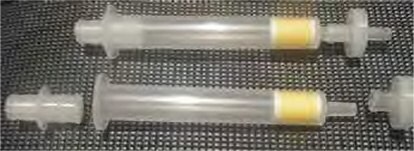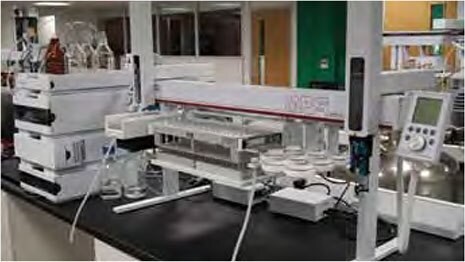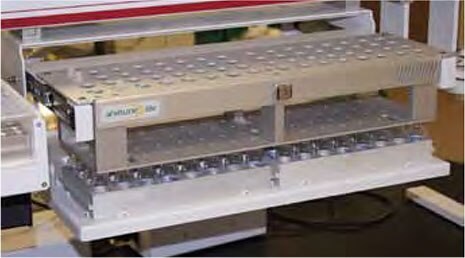Determination of Formaldehyde and Acetaldehyde in Air Using DNPH Cartridges and Automated On-Line Desorption Followed by HPLC
Dan Carrier
Anatune Ltd, Girton, Cambridge, UK
US Reporter Volume 30.3
Introduction
Airborne aldehydes and ketones are collected by passing air through a cartridge containing 2,4-dinitrophenylhydrazine (DNPH). Carbonyl compounds react with the DNPH to form hydrazones, which are immobilized on the cartridge. These compounds can be easily eluted from the cartridge with acetonitrile and analyzed by HPLC with UV detection. Traditionally, this analysis including the workup contains a series of manual steps, which can become time-consuming and could cause experimental error.
Method
In the discussed study, a required amount of air to be tested is passed through a Supelco® LpDNPH S10 cartridge. The manual desorption process is detailed as follows: Each cartridge is placed into a vacuum manifold and acetonitrile is used to elute the derivatized aldehyde or ketone from the cartridge. The extract is collected into a 5 mL volumetric flask and the flow of acetonitrile is stopped when 5 mL has been collected. This is performed by eye, checking that the top of the meniscus has reached the 5 mL mark. The volume of extract collected is critical as the concentration of the derivatized product will be dependent on the volume collected. The extract is then shaken to ensure that the solution is adequately mixed and subsequently filtered using a 0.2 micron PTFE filter, and a portion of this solution is then pipetted into a vial for HPLC analysis by UV detection.
To automate this method, a good seal is required between the DNPH cartridge and the injection needle from the syringe, which is attached to a GERSTEL® MultiPurpose Sampler (MPS) head. This will allow delivery of the solvent through the cartridge. Figure 1 shows a photograph of a DNPH cartridge with a sealing unit (transport adapter) and 0.2 micron filter. From previous experimental work, it has been found that the addition of 5.6 mL of acetonitrile to the cartridge will produce a 5 mL extract. A 5 mL extract is obtained as residual acetonitrile is left on the cartridge. Figure 2 shows the instrumentation used to automate the DNPH process. In the development of this automated method, acetonitrile was collected from 20 different automated extractions and the precision for the volume of acetonitrile extracted was calculated to be 1.5% relative standard deviation on a 5 mL extract.

Figure 1.DNPH Cartridge with Sealing Unit

Figure 2.Anatune 300 Instrument
Airborne formaldehyde and acetaldehyde were collected onto various DNPH cartridges using a proprietary method. A transport adapter and filter were attached to the cartridge and placed onto the Anatune™ 300 unit. The cartridges were subsequently analyzed. Levels of the derivatized formaldehyde and acetaldehyde were quantified on the automated system using an external standard (T011/IP-6A Aldehyde/Ketone-DNPH Mix from Supelco).
After the DNPH cartridge has been aligned with an empty 10 mL vial, 5.6 mL of acetonitrile is added to the cartridge using a 5 mL syringe on an MPS head. Additional air is pushed through the cartridge to maximize the amount of extract produced. The extract is then mixed and a 1 mL aliquot of the extract (using a 1 mL syringe) and is added to a sealed 2 mL HPLC vial which is seated within the cooled tray. The extract is subsequently injected onto the HPLC. The LC method uses an Ascentis® Express C18, 5 cm x 4.6 mm I.D. column with a gradient starting at 30:70 acetonitrile:water (v/v) up to 95:05 acetonitrile:water (v/v) with UV detection at 365 nm. Full details of the method are given in Table 1. With the Prep-Ahead function, in the MAESTRO software, the automated sample preparation can be incorporated within the HPLC run time which is 12.5 minutes long.
Up to 64 extractions including the HPLC analysis can be automated. The cooled tray, set to 4 °C, allows re-injection of the samples and standards if required. Figure 2 shows the instrumentation used together with a photograph of the how it is configured. Figure 3 shows a close up of the automated DNPH unit (Anatune 300).

Figure 3.Closeup of the Automated DNPH Unit (Anatune 300)
Results
Figure 4 shows an example chromatogram of 0.075 ppm formaldehyde and acetaldehyde standard. Formaldehyde elutes at 3.7 minutes and acetaldehyde at 5.3 minutes. Six replicate injections of the 5 ppm standard were performed giving a percent relative standard deviation of 1.2% for formaldehyde and 1.3% for acetaldehyde. Levels of formaldehyde and acetaldehyde in the sample were consistent with the manual method. Figure 5 shows an example chromatogram of a sample containing formaldehyde and acetaldehyde. Table 2 shows the results obtained from five different sampled DNPH cartridges for formaldehyde and acetaldehyde using the automated process. Levels calculated from injecting an external 0.075 ppm standard of formaldehyde and acetaldehyde.

Figure 4.0.075 ppm Formaldehyde and Acetaldehyde Standard

Figure 5.Example Chromatogram of a Sample Containing Formaldehyde and Acetaldehyde
Conclusion
Automating the extraction of LpDNPH S10 cartridges and putting it in-line with the HPLC analysis will significantly reduce manual labor using this technique and this will improve reproducibility of the method by reducing potential experimental errors by the operator. The automation and unattended operation of the method leads to high throughput for determining airborne formaldehyde and acetaldehyde.
To continue reading please sign in or create an account.
Don't Have An Account?